8
1
0
2
y
a
M
4
2
]
R
I
.
s
c
[
2
v
9
4
3
2
0
.
3
0
8
1
:
v
i
X
r
a
Billion-scale Commodity Embedding for E-commerce
Recommendation in Alibaba
Jizhe Wang, Pipei Huang∗
Alibaba Group
Hangzhou and Beijing, China
{jizhe.wjz,pipei.hpp}@alibaba-inc.com
{jizhe.wjz,pipei.hpp}@gmail.com
Zhibo Zhang, Binqiang Zhao
Alibaba Group
Beijing, China
{shaobo.zzb,binqiang.zhao}@alibaba-inc.com
Huan Zhao
Department of Computer Science and Engineering
Hong Kong University of Science and Technology
Kowloon, Hong Kong
hzhaoaf@cse.ust.hk
Dik Lun Lee
Kowloon, Hong Kong
dlee@cse.ust.hk
Department of Computer Science and Engineering
Hong Kong University of Science and Technology
ABSTRACT
Recommender systems (RSs) have been the most important
technology for increasing the business in Taobao, the largest online
consumer-to-consumer (C2C) platform in China. There are three
major challenges facing RS in Taobao: scalability, sparsity and
cold start. In this paper, we present our technical solutions to
address these three challenges. The methods are based on a well-
known graph embedding framework. We first construct an item
graph from users’ behavior history, and learn the embeddings of all
items in the graph. The item embeddings are employed to compute
pairwise similarities between all items, which are then used in
the recommendation process. To alleviate the sparsity and cold
start problems, side information is incorporated into the graph
embedding framework. We propose two aggregation methods to
integrate the embeddings of items and the corresponding side
information. Experimental results from offline experiments show
that methods incorporating side information are superior to those
that do not. Further, we describe the platform upon which the
embedding methods are deployed and the workflow to process
the billion-scale data in Taobao. Using A/B test, we show that the
online Click-Through-Rates (CTRs) are improved comparing to
the previous collaborative filtering based methods widely used in
Taobao, further demonstrating the effectiveness and feasibility of
our proposed methods in Taobao’s live production environment.
CCS CONCEPTS
• Information systems → Collaborative filtering; Recom-
mender systems; • Mathematics of computing → Graph
∗Pipei Huang is the Corresponding author.
Permission to make digital or hard copies of all or part of this work for personal or
classroom use is granted without fee provided that copies are not made or distributed
for profit or commercial advantage and that copies bear this notice and the full citation
on the first page. Copyrights for components of this work owned by others than ACM
must be honored. Abstracting with credit is permitted. To copy otherwise, or republish,
to post on servers or to redistribute to lists, requires prior specific permission and/or a
fee. Request permissions from permissions@acm.org.
KDD ’18, August 19–23, 2018, London, United Kingdom
© 2018 Association for Computing Machinery.
ACM ISBN 978-1-4503-5552-0/18/08...$15.00
https://doi.org/10.1145/3219819.3219869
algorithms; • Computing methodologies → Learning latent
representations;
KEYWORDS
Recommendation system; Collaborative filtering;
Graph Embedding; E-commerce Recommendation.
1 INTRODUCTION
Internet technology has been continuously reshaping the business
landscape, and online businesses are everywhere nowadays.
Alibaba, the largest provider of online business in China, makes it
possible for people or companies all over the world to do business
online. With one billion users, the Gross Merchandise Volume
(GMV) of Alibaba in 2017 is 3,767 billion Yuan and the revenue
in 2017 is 158 billion Yuan. In the famous Double-Eleven Day, the
largest online shopping festival in China, in 2017, the total amount
of transactions was around 168 billion Yuan. Among all kinds of
online platforms in Alibaba, Taobao1, the largest online consumer-
to-consumer (C2C) platform, stands out by contributing 75% of the
total traffic in Alibaba E-commerce.
With one billion users and two billion items, i.e., commodities,
in Taobao, the most critical problem is how to help users find
the needed and interesting items quickly. To achieve this goal,
recommendation, which aims at providing users with interesting
items based on their preferences, becomes the key technology in
Taobao. For example, the homepage on Mobile Taobao App (see
Figure 1), which are generated based on users’ past behaviors
with recommendation techniques, contributes 40% of the total
recommending traffic. Furthermore, recommendation contributes
the majority of both revenues and traffic in Taobao. In short, rec-
ommendation has become the vital engine of GMV and revenues of
Taobao and Alibaba. Despite the success of various recommendation
methods in academia and industry, e.g., collaborative filtering
(CF) [9, 11, 16], content-based methods [2], and deep learning based
methods [5, 6, 22], the problems facing these methods become more
severe in Taobao because of the billion-scale of users and items.
There are three major technical challenges facing RS in Taobao:
1https://www.taobao.com/
�
Figure 1: The areas highlighted with dashed rectangles are personalized for one billion users in Taobao. Attractive images
and textual descriptions are also generated for better user experience. Note they are on Mobile Taobao App homepage, which
contributes 40% of the total recommending traffic.
• Scalability: Despite the fact that many existing recommen-
dation approaches work well on smaller scale datasets, i.e.,
millions of users and items, they fail on the much larger
scale dataset in Taobao, i.e., one billion users and two billion
items.
• Sparsity: Due to the fact that users tend to interact with
only a small number of items, it is extremely difficult to train
an accurate recommending model, especially for users or
items with quite a small number of interactions. It is usually
referred to as the “sparsity” problem.
• Cold Start: In Taobao, millions of new items are contin-
uously uploaded each hour. There are no user behaviors
for these items. It is challenging to process these items or
predict the preferences of users for these items, which is the
so-called “cold start” problem.
To address these challenges in Taobao, we design a two-stage
recommending framework in Taobao’s technology platform. The
first stage is matching, and the second is ranking. In the matching
stage, we generate a candidate set of similar items for each item
users have interacted with, and then in the ranking stage, we train
a deep neural net model, which ranks the candidate items for each
user according to his or her preferences. Due to the aforementioned
challenges, in both stages we have to face different unique problems.
Besides, the goal of each stage is different, leading to separate
technical solutions.
In this paper, we focus on how to address the challenges in
the matching stage, where the core task is the computation of
pairwise similarities between all items based on users’ behaviors.
After the pairwise similarities of items are obtained, we can generate
a candidate set of items for further personalization in the ranking
stage. To achieve this, we propose to construct an item graph
from users’ behavior history and then apply the state-of-art graph
embedding methods [8, 15, 17] to learn the embedding of each item,
dubbed Base Graph Embedding (BGE). In this way, we can generate
the candidate set of items based on the similarities computed
from the dot product of the embedding vectors of items. Note
that in previous works, CF based methods are used to compute
these similarities. However, CF based methods only consider the
co-occurrence of items in users’ behavior history [9, 11, 16].
In our work, using random walk in the item graph, we can
capture higher-order similarities between items. Thus, it is superior
to CF based methods. However, it’s still a challenge to learn
accurate embeddings of items with few or even no interactions.
To alleviate this problem, we propose to use side information to
enhance the embedding procedure, dubbed Graph Embedding with
Side information (GES). For example, items belong to the same
category or brand should be closer in the embedding space. In
this way, we can obtain accurate embeddings of items with few
or even no interactions. However, in Taobao, there are hundreds
of types of side information, like category, brand, or price, etc.,
and it is intuitive that different side information should contribute
differently to learning the embeddings of items. Thus, we further
propose a weighting mechanism when learning the embedding
with side information, dubbed Enhanced Graph Embedding with
Side information (EGES).
In summary, there are three important parts in the matching
stage:
(1) Based on years of practical experience in Taobao, we design
an effective heuristic method to construct the item graph
from the behavior history of one billion users in Taobao.
(2) We propose three embedding methods, BGE, GES, and EGES,
to learn embeddings of two billion items in Taobao. We
conduct offline experiments to demonstrate the effectiveness
of GES and EGES comparing to BGE and other embedding
methods.
(3) To deploy the proposed methods for billion-scale users and
items in Taobao, we build the graph embedding systems on
the XTensorflow (XTF) platform constructed by our team. We
�
show that the proposed framework significantly improves
recommending performance on the Mobile Taobao App,
while satisfying the demand of training efficiency and instant
response of service even on the Double-Eleven Day.
The rest of the paper is organized as follows. In Section 2, we
elaborate on the three proposed embedding methods. Offline and
online experimental results are presented in Section 3. We introduce
the deployment of the system in Taobao in Section 4, and review
the related work in Section 5. We conclude our work in Section 6.
2 FRAMEWORK
In this section, we first introduce the basics of graph embedding,
and then elaborate on how we construct the item graph from users’
behavior history. Finally, we study the proposed methods to learn
the embeddings of items in Taobao.
2.1 Preliminaries
In this section, we give an overview of graph embedding and one of
the most popular methods, DeepWalk [15], based on which we
propose our graph embedding methods in the matching stage.
Given a graph G = (V, E), where V and E represent the node
set and the edge set, respectively. Graph embedding is to learn a
low-dimensional representation for each node v ∈ V in the space
Rd, where d ≪ |V|. In other words, our goal is to learn a mapping
function Φ : V → Rd, i.e., representing each node in V as a
d-dimensional vector.
In [13, 14], word2vec was proposed to learn the embedding of
each word in a corpus. Inspired by word2vec, Perozzi et al. proposed
DeepWalk to learn the embedding of each node in a graph [15].
They first generate sequences of nodes by running random walk
in the graph, and then apply the Skip-Gram algorithm to learn
the representation of each node in the graph. To preserve the
topological structure of the graph, they need to solve the following
optimization problem:
minimize
− log Pr(c|Φ(v)) ,
�
�
(1)
Φ
v ∈V
c∈N(v)
where N(v) is the neighborhood of node v, which can be defined
as nodes within one or two hops from v. Pr(c|Φ(v)) defines the
conditional probability of having a context node c given a node v.
In the rest of this section, we first present how we construct
the item graph from users’ behaviors, and then propose the
graph embedding methods based on DeepWalk for generating low-
dimensional representation for two billion items in Taobao.
2.2 Construction of Item Graph from Users’
Behaviors
In this section, we elaborate on the construction of the item graph
from users’ behaviors. In reality, a user’s behaviors in Taobao tend
to be sequential as shown in Figure 2 (a). Previous CF based methods
only consider the co-occurrence of items, but ignore the sequential
information, which can reflect users’ preferences more precisely.
However, it is not possible to use the whole history of a user because
1) the computational and space cost will be too expensive with so
many entries; 2) a user’s interests tend to drift with time. Therefore,
in practice, we set a time window and only choose users’ behaviors
within the window. This is called session-based users’ behaviors.
Empirically, the duration of the time window is one hour.
After we obtain the session-based users’ behaviors, two items
are connected by a directed edge if they occur consecutively, e.g.,
in Figure 2 (b) item D and item A are connected because user u1
accessed item D and A consecutively as shown in Figure 2 (a).
By utilizing the collaborative behaviors of all users in Taobao, we
assign a weight to each edge eij based on the total number of
occurrences of the two connected items in all users’ behaviors.
Specifically, the weight of the edge is equal to the frequency of
item i transiting to item j in the whole users’ behavior history. In
this way, the constructed item graph can represent the similarity
between different items based on all of the users’ behaviors in
Taobao.
In practice, before we extract users’ behavior sequences, we need
to filter out invalid data and abnormal behaviors to eliminate noise
for our proposed methods. Currently, the following behaviors are
regarded as noise in our system:
the click may be unintentional and needs to be removed.
• If the duration of the stay after a click is less than one second,
• There are some “over-active” users in Taobao, who are ac-
tually spam users. According to our long-term observations
in Taobao, if a single user bought 1,000 items or his/her
total number of clicks is larger than 3,500 in less than three
months, it is very likely that the user is a spam user. We need
to filter out the behaviors of these users.
• Retailers in Taobao keep updating the details of a commodity.
In the extreme case, a commodity can become a totally
different item for the same identifier in Taobao after a long
sequence of updates. Thus, we remove the item related to
the identifier.
2.3 Base Graph Embedding
After we obtain the weighted directed item graph, denoted as G =
(V, E), we adopt DeepWalk to learn the embedding of each node
in G. Let M denote the adjacency matrix of G and Mij the weight
of the edge from node i pointing to node j. We first generate node
sequences based on random walk and then run the Skip-Gram
algorithm on the sequences. The transition probability of random
walk is defined as
Mi j�
j∈N+(vi )
0 ,
P(vj|vi) =
, vj ∈ N+(vi) ,
Mi j
eij E ,
(2)
where N+(vi) represents the set of outlink neighbors, i.e. there are
edges from vi pointing to all of the nodes in N+(vi). By running
random walk, we can generate a number of sequences as shown in
Figure 2 (c).
Then we apply the Skip-Gram algorithm [13, 14] to learn the
embeddings, which maximizes the co-occurrence probability of
two nodes in the obtained sequences. This leads to the following
optimization problem:
− log Pr{vi−w , · · · , vi +w}\vi|Φ(vi) ,
(3)
minimize
Φ
�
(a) Users’ behavior sequences.
(b) Item graph construction.
(c) Random walk generation.
(d) Embedding with Skip-Gram.
Figure 2: Overview of graph embedding in Taobao: (a) Users’ behavior sequences: One session for user u1, two sessions for
user u2 and u3; these sequences are used to construct the item graph; (b) The weighted directed item graph G = (V, E); (c) The
sequences generated by random walk in the item graph; (d) Embedding with Skip-Gram.
where w is the window size of the context nodes in the sequences.
Using the independence assumption, we have
Pr{vi−w , · · · , vi +w}\vi|Φ(vi) =
log σΦ(vj)T Φ(vi) + �
into
minimize
Φ
t ∈N(vi)′
j=i−w, ji
i +w�
Prvj|Φ(vi) .
log σ − Φ(vt)T Φ(vi) .
(4)
Applying negative sampling [13, 14], Eq. (3) can be transformed
(5)
where N(vi)′ is the negative samples for vi, and σ() is the sigmoid
1+e−x . Empirically, the larger |N(vi)′| is, the better
function σ(x) =
1
the obtained results.
2.4 Graph Embedding with Side Information
By applying the embedding method in Section 2.3, we can
learn embeddings of all items in Taobao to capture higher-order
similarities in users’ behavior sequences, which are ignored by
previous CF based methods. However, it is still challenging to
learn accurate embeddings for “cold-start” items, i.e., those with no
interactions of users.
To address the cold-start problem, we propose to enhance BGE
using side information attached to cold-start items. In the context
of RSs in e-commerce, side information refers to the category, shop,
price, etc., of an item, which are widely used as key features in
the ranking stage but rarely applied in the matching stage. We can
alleviate the cold-start problem by incorporating side information
in graph embedding. For example, two hoodies (same category)
from UNIQLO (same shop) may look alike, and a person who likes
Nikon lens may also has an interest in Canon Camera (similar
category and similar brand). It means that items with similar side
information should be closer in the embedding space. Based on this
assumption, we propose the GES method as illustrated in Figure 3.
For the sake of clarity, we modify slightly the notations. We use
W to denote the embedding matrix of items or side information.
Specifically, W0
v denotes
the embedding of the s-th type of side information attached to
item v. Then, for item v with n types of side information, we have
v denotes the embedding of item v, and Ws
v ∈ Rd, where d is the embedding
n + 1 vectors W0
dimension. Note that the dimensions of the embeddings of items
and side information are empirically set to the same value.
v , · · · , ...Wn
As shown in Figure 3, to incorporate side information, we
concatenate the n + 1 embedding vectors for item v and add a layer
with average-pooling operation to aggregate all of the embeddings
related to item v, which is
n�
s =0
Hv =
1
n + 1
Ws
v ,
(6)
where Hv is the aggregated embeddings of item v. In this way, we
incorporate side information in such a way that items with similar
side information will be closer in the embedding space. This results
in more accurate embeddings of cold-start items and improves the
offline and online performance (see Section 3).
2.5 Enhanced Graph Embedding with Side
Information
Despite the performance gain of GES, a problem remains when
integrating different kinds of side information in the embedding
procedure. In Eq. (6), the assumption is that different kinds of side
information contribute equally to the final embedding, which does
not reflect the reality. For example, a user who has bought an iPhone
tends to view Macbook or iPad because of the brand “Apple”, while
a user may buy clothes of different brands in the same shop in
Taobao for convenience and lower price. Therefore, different kinds
of side information contribute differently to the co-occurrence of
items in users’ behaviors.
To address this problem, we propose the EGES method to
aggregate different types of side information. The framework is the
same to GES (see Figure 3). The idea is that different types of side
information have different contributions when their embeddings
are aggregated. Hence, we propose a weighted average layer to
aggregate the embeddings of the side information related to the
items. Given an item v, let A ∈ R|V |×(n+1) be the weight matrix
and the entry Aij the weight of the j-th type of side information
of the i-th item. Note that A∗0, i.e., the first column of A, denotes
the weight of item v itself. For simplicity, we use as
v to denote
�
The pseudo code of EGES is listed in Algorithm 1, and the pseudo
code of the weighted Skip-Gram updater is shown in Algorithm 2.
The final hidden representation of each item is computed by Eq. (7).
Algorithm 1 Framework of EGES.
INPUT:
OUTPUT:
The item graph G = (V, E), side information S, number of
walks per node w, walk length l, Skip-Gram window size k,
number of negatives samples #ns, embedding dimension d;
The item & side-information embeddings W0
Weight matrix A;
1: Initialize W0
2: for i = 1 → w do
for v ∈ V do
3:
4:
5:
end for
6:
7: end for
8: return W0
SEQ = RandomWalk(G,v,l); (Eq. (2))
WeightedSkipGram(W0
, . . . , Wn, A, k, #ns, l, SEQ);
, . . . , Wn, A;
, . . . , Wn, A;
, . . . , Wn
Figure 3: The general framework of GES and EGES. SI
denotes the side information, and “SI 0” represents the
item itself. In practice, 1) Sparse features tend to be one-
hot-encoder vectors for items and different SIs. 2) Dense
embeddings are the representation of items and the corre-
sponding SI. 3) The hidden representation is the aggregation
embedding of an item and its corresponding SI.
�n
�n
j =0 ea j
v Wj
v
j=0 ea j
v
0
the weight of the s-th type of side information of item v with a
v
denoting the weight of item v itself. The weighted average layer
combining different side information is defined in the following:
Hv =
,
(7)
v instead of a
where we use ea j
each side information is greater than 0, and�n
v to ensure that the contribution of
j
v is used to
normalize the weights related to the embeddings of different side
information.
For node v and its context node u in the training data, we use
Zu ∈ Rd to represent its embedding and y to denote the label. Then,
the objective function of EGES becomes
L(v, u, y) = −[yloд(σ(HT
v Zu)) + (1 − y)loд(1 − σ(HT
To solve it, the gradients are derived in the following:
v Zu))] .
j=0 ea j
(8)
∂L
∂Zu
= (σ(HT
v Zu) − y)Hv .
(9)
, · · · , Wn, A, k, #ns, l, SEQ)
for i = 1 → l do
v = SEQ[i];
for j = max(0, i − k) → min(i + k, l) & j i do
Algorithm 2 Weighted Skip-Gram.
1: function WeightedSkipGram(W0
2:
3:
4:
5:
6:
7:
8:
9:
10:
11:
12:
13: end function
u = SEQ[j]
Update(v, u, 1)
for t = 0 → #ns do
u = N eдativeSamplinд(V)
Update(v, u, 0)
end for
end for
end for
L; (Eq. (9))
= Zold
Znew
u
for s = 0 → n do
14: function Update(v, u, y)
u − η · ∂
15:
∂Zu
16:
= as
17:
v
= Wsold
as new
v
Ws new
18:
19:
20: end function
v
end for
old − η · ∂L
∂as
v
− η · ∂L
∂Ws
v
v
; (Eq. (10))
; (Eq. (11))
For s-th side information
∂L
∂as
v
=
∂Hv
∂as
v
v Zu) − y)Zu
∂L
∂Hv
= (σ(HT
(�n
j=0 ea j
v )eas
j=0 ea j
v Wj
v
v�n
v Ws
(�n
v − eas
v )2
j=0 ea j
∂L
∂Ws
v
=
=
∂L
∂Hv
eas
j=0 ea j
v�n
∂Hv
∂Ws
v
(σ(HT
v
v Zu) − y)Zu .
,
3 EXPERIMENTS
In this section, we conduct extensive experiments to demonstrate
the effectiveness of our proposed methods. First, we evaluate the
methods by the link prediction task, and then report the online
experimental results on Mobile Taobao App. Finally, we present
some real-world cases to give insight into the proposed methods in
Taobao.
(10)
(11)
�
Table 1: Statistics of the two datasets. #SI denotes the number
of types of side information. Sparsity is computed according
to 1 −
#Edдes
#N odes×(#N odes−1).
#Nodes
Dataset
300,150
Amazon
Taobao
2,632,379
#Edges
3,740,196
44,997,887
#SI
3
12
Sparsity(%)
0.9958
0.9994
3.1 Offline Evaluation
Link Prediction. The link prediction task is used in the offline
experiments because it is a fundamental problem in networks. Given
a network with some edges removed, the link prediction task is
to predict the occurrence of links. Following similar experimental
settings in [30], 1/3 of the edges are randomly chosen and removed
as ground truth in the test set, and the remaining graph is taken as
the training set. The same number of node pairs in the test data with
no edges connecting them are randomly chosen as negative samples
in the test set. To evaluate the performance of link prediction,
the Area Under Curve (AUC) score is adopted as the performance
metric.
Dataset. We use two datasets for the link prediction task. The
first is Amazon Electronics2 provided by [12], denoted as Amazon.
The second is extracted from Mobile Taobao App, denoted as
Taobao. Both of these two datasets include different types of side
information. For the Amazon dataset, the item graph is constructed
from “co-purchasing” relations (denoted as also_bought in the
provided data), and three types of side information are used, i.e.,
category, sub-category and brand. For the Taobao dataset, the item
graph is constructed according to Section 2.2. Note that, for the sake
of efficiency and effectiveness, twelve types of side information are
used in Taobao’s live production, including retailer, brand, purchase
level, age, gender, style, etc. These types of side information have
been demonstrated to be useful according to years of practical
experience in Taobao. The statistics of the two datasets are shown
in Table 1. We can see that the sparsity of the two datasets are
greater than 99%.
Comparing Methods. Experiments are conducted to compare
four methods: BGE, LINE, GES, and EGES. LINE was proposed
in [17], which captures the first-order and second-order proximity
in graph embedding. We use the implementation provided by the
authors3, and run it using first-order and second-order proximity,
which are denoted, respectively, as LINE(1st) and LINE(2nd). We
implement the other three methods. The emdedding dimension
of all the methods is set to 160. For our BGE, GES and EGES, the
length of random walk is 10, the number of walks per node is 20,
and the context window is 5.
Results Analysis. The results are shown in Table 2. We
can see that GES and EGES outperform BGE, LINE(1st) and
LINE(2st) in terms of AUC on both datasets. This demonstrates
the effectiveness of the proposed methods. In other words, the
sparsity problem is alleviated by incorporating side information.
When comparing the improvements on Amazon and Taobao, we
can see that the performance gain is more significant on Taobao
2http://jmcauley.ucsd.edu/data/amazon/
3https://github.com/tangjianpku/LINE
Table 2: AUCs of different methods on the two datasets.
Percentages in the brackets are the improvements of AUC
comparing to BGE.
Dataset
BGE
LINE(1st)
LINE(2nd)
GES
EGES
Amazon
0.9327
0.9554(+2.43%)
0.8664(-7.65%)
0.9575(+2.66%)
0.9700(+4.00%)
Taobao
0.8797
0.9100(+3.44%)
0.9411(+6.98%)
0.9704(+10.1%)
0.9746(+10.8%)
dataset. We attribute this to the larger number of types of effective
and informative side information used on Taobao dataset. When
comparing GES and EGES, we can see that the performance gain on
Amazon is lager than that on Taobao. It may be due to the fact that
the performance on Taobao is already very good, i.e., 0.97. Thus,
the improvement of EGES is not prominent. On Amazon dataset,
EGES outperforms GES significantly in terms of AUC. Based on
these results, we can observe that incorporating side information
can be very useful for graph embedding, and the accuracy can be
further improved by weighted aggregation of the embeddings of
various side information.
Figure 4: Online CTRs of different methods in seven days in
November 2017.
3.2 Online A/B Test
We conduct online experiments in an A/B testing framework. The
experimental goal is Click-Through-Rate (CTR) on the homepage
of Mobile Taobao App. We implement the above graph embedding
methods and then generate a number of similar items for each
item as recommendation candidates. The final recommending
results on the homepage in Taobao (see Figure 1) is generated
by the ranking engine, which is implemented based on a deep
neural network model. We use the same method to rank the
candidate items in the experiment. As mentioned above, the quality
of the similar items directly affects the recommending results.
Therefore, the recommending performance, i.e., CTR, can represent
�
the effectiveness of different methods in the matching stage. We
deploy the four methods in an A/B test framework and the results
of seven days in November 2017 are shown in Figure 4. Note that
“Base” represents an item-based CF method which has been widely
used in Taobao before graph embedding methods was deployed.
It calculates the similarity between two items according to item
co-occurrence and user voting weight. The similarity measurement
is well-tuned and suitable for Taobao’s business.
From Figure 4, we can see that EGES and GES outperform
BGE and Base consistently in terms of CTR, which demonstrates
the effectiveness of the incorporation of side information in
graph embedding. Further, the CTR of Base is larger than that
of BGE. It means that well-tuned CF based methods can beat
simple embedding method because a large number of hand-crafted
heuristic strategies have been exploited in practice. On the other
hand, EGES outperforms GES consistently, which aligns with the
results in the offline experimental results in Section 3.1. It further
demonstrates that weighted aggregation of side information is
better than average aggregation.
3.3 Case Study
In this section, we present some real-world cases in Taobao to
illustrate the effectiveness of the proposed methods. The cases are
examined in three aspects: 1) visualization of the embeddings by
EGES, 2) cold start items, and 3) weights in EGES.
3.3.1 Visualization. In this part, we visualize the embeddings
of items learned by EGES. We use the visualization tool provided
by tensorflow4. The results are shown in Figure 7. From Figure 7
(a), we can see that shoes of different categories are in separate
clusters. Here one color represents one category of shoes, like
badminton, table tennis, or football shoes. It demonstrates the
effectiveness of the learned embeddings with incorporation of side
information, i.e., items with similar side information should be
closer in the embedding space. From Figure 7 (b), we further analyze
the embeddings of three kinds of shoes: badminton, table tennis, and
football. It is very interesting to observe that badminton and table
tennis shoes are closer to each other while football shoes are farther
in the embedding space. This can be explained by a phenomenon
that people in China who like table tennis have much overlapping
with those who like badminton. However, those who like football
are quite different from those who like indoor sports, i.e., table
tennis and badminton. In this sense, recommending badminton
shoes to those who have viewed table tennis shoes is much better
than recommending football shoes.
3.3.2 Cold Start Items. In this part, we show the quality of the
embeddings of cold start items. For a newly updated item in Taobao,
no embedding can be learned from the item graph, and previous
CF based methods also fail in handling cold start items. Thus, we
represent a cold start item with the average embeddings of its side
information. Then, we retrieve the most similar items from the
existing items based on the dot product of the embeddings of two
items. The results are shown in Figure 5. We can see that despite the
missing of users’ behaviors for the two cold start items, different side
information can be utilized to learn their embeddings effectively
4http://projector.tensorflow.org/
Figure 5: Similar items for cold start items. Top 4 similar
items are shown. Note that “cat” means category.
in terms of the quality of the top similar items. In the figure,
we annotate for each similar item the types of side information
connected to the cold start item. We can see that the shops of the
items are very informative for measuring the similarity of two
items, which also aligns with the weight of each side information
in the following part.
Figure 6: Weights for different side information of various
items. Here “Item” means the embedding of an item itself.
3.3.3 Weights in EGES. In this part, we visualize the weights of
different types of side information for various items. Eight items
in different categories are selected and the weights of all side
information related to these items are extracted from the learned
weight matrix A. The results are shown in Figure 6, where each
row records the results of one item. Several observations are worth
noting: 1) The weight distributions of different items are different,
which aligns with our assumption that different side information
contribute differently to the final representation. 2) Among all the
items, the weights of “Item”, representing the embeddings of the
item itself, are consistently larger than those of all the other side
information. It confirms the intuition that the embedding of an
item itself remains to be the primary source of users’ behaviors
whereas side information provides additional hints for inferring
users’ behaviors. 3) Besides “Item”, the weights of “Shop” are
consistently larger than those of the other side information. It aligns
with users’ behaviors in Taobao, that is, users tend to purchase items
in the same shop for convenience and lower price.
�
(a) Visualization of sports shoes of all categories.
(b) Visualization of badminton, table tennis and football shoes. Items in
gray do not belong to any of the three categories.
Figure 7: Visualization of the learned embeddings of a set of randomly chosen shoes. Item embeddings are projected into a
2-D plane via principal component analysis (PCA). Different colors represent different categories. Items in the same category
are grouped together.
4 SYSTEM DEPLOYMENT AND OPERATION
In this section, we introduce the implementation and deployment
of the proposed graph embedding methods in Taobao. We first give
a high-level introduction of the whole recommending platform
powering Taobao and then elaborate on the modules relevant to
our embedding methods.
• Users’ behaviors during their visits in Taobao are collected
and saved as log data for the offline subsystem.
The workflow of the offline subsystem, where graph embedding
methods are implemented and deployed, is described in the
following:
• The logs including users’ behaviors are retrieved. The item
graph is constructed based on the users’ behaviors. In
practice, we choose the logs in the recent three months.
Before generating session-based users’ behavior sequences,
anti-spam processing is applied to the data. The remaining
logs contains about 600 billion entries. Then, the item
graph is constructed according to the method described in
Section 2.2.
• To run our graph embedding methods, two practical solu-
tions are adopted: 1) The whole graph is split into a number
of sub-graphs, which can be processed in parallel in Taobao’s
Open Data Processing Service (ODPS) distributed platform.
There are around 50 million nodes in each subgraph. 2) To
generate the random walk sequences in the graph, we use
our iteration-based distributed graph framework in ODPS.
The total number of generated sequences by random walk
is around 150 billion.
• To implement the proposed embedding algorithms, 100
GPUs are used in our XTF platform. On the deployed
platform, with 150 billion samples, all modules in the offline
subsystem, including log retrieval, anti-spam processing,
item graph construction, sequence generation by random
walk, embedding, item-to-item similarity computation and
map generation, can be executed in less than six hours.
Thus, our recommending service can respond to users’ latest
behaviors in a very short time.
Figure 8: Architecture of the recommending platform in
Taobao.
In Figure 8, we show the architecture of the recommending
platform in Taobao. The platform consists of two subsystems: online
and offline. For the online subsystem, the main components are
Taobao Personality Platform (TPP) and Ranking Service Platform
(RSP). A typical workflow is illustrated in the following:
• When a user launches Mobile Taobao App, TPP extracts
the user’s latest information and retrieves a candidate set of
items from the offline subsystem, which is then fed to RSP.
RSP ranks the candidate set of items with a fine-tuned deep
neural net model and returns the ranked results to TPP.
�
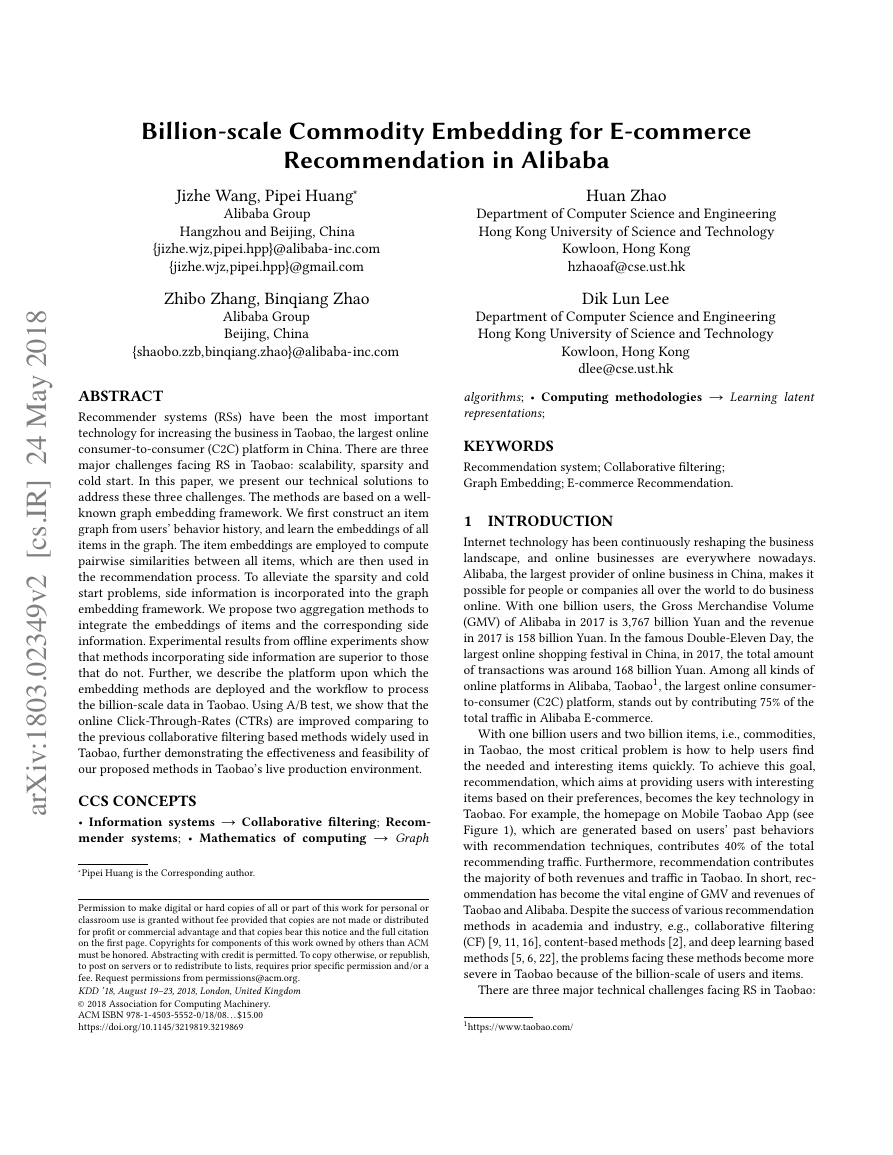

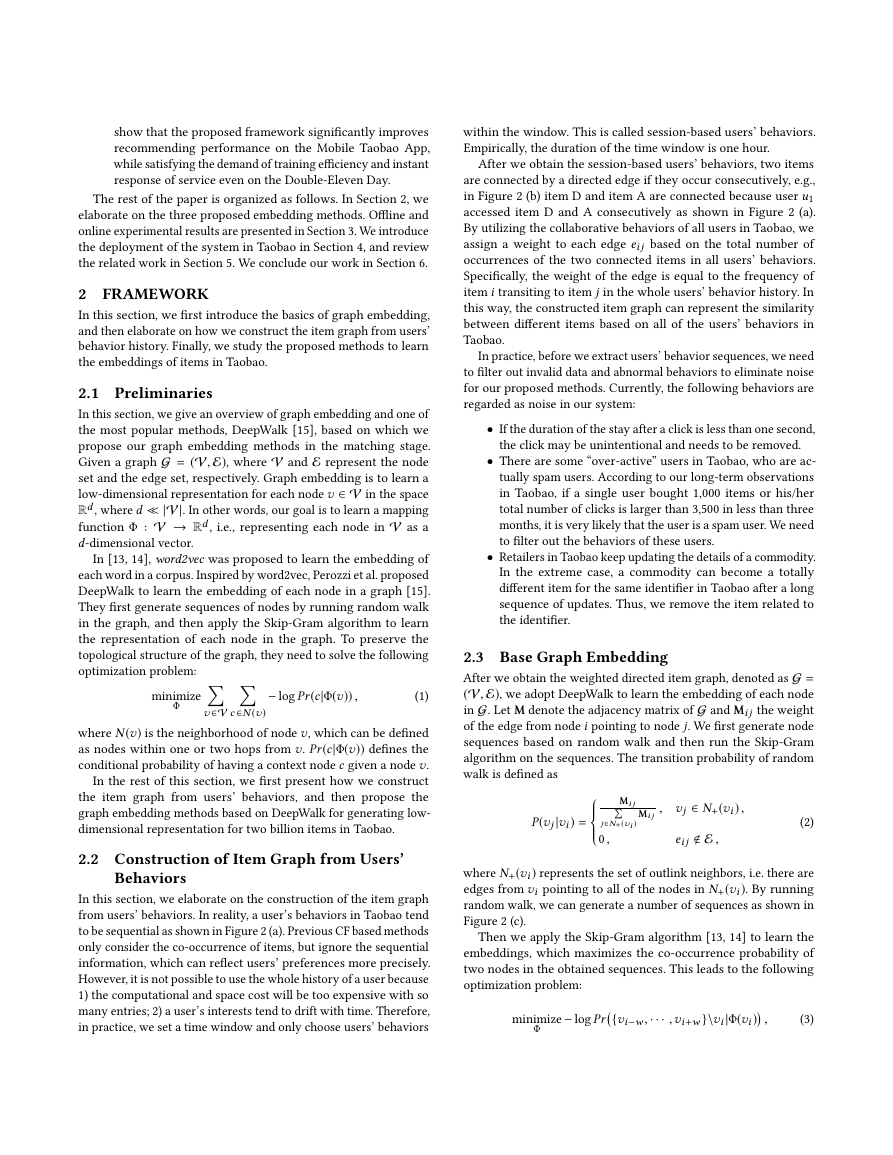
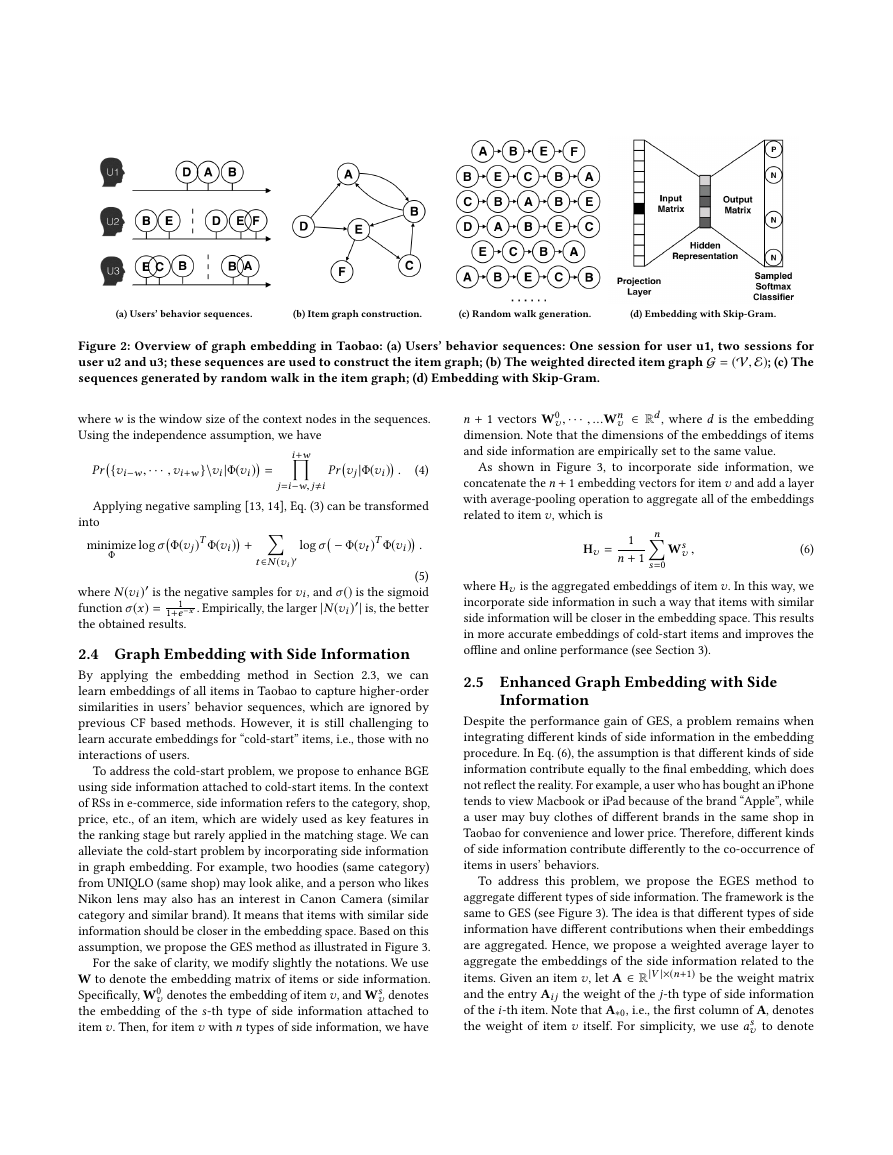
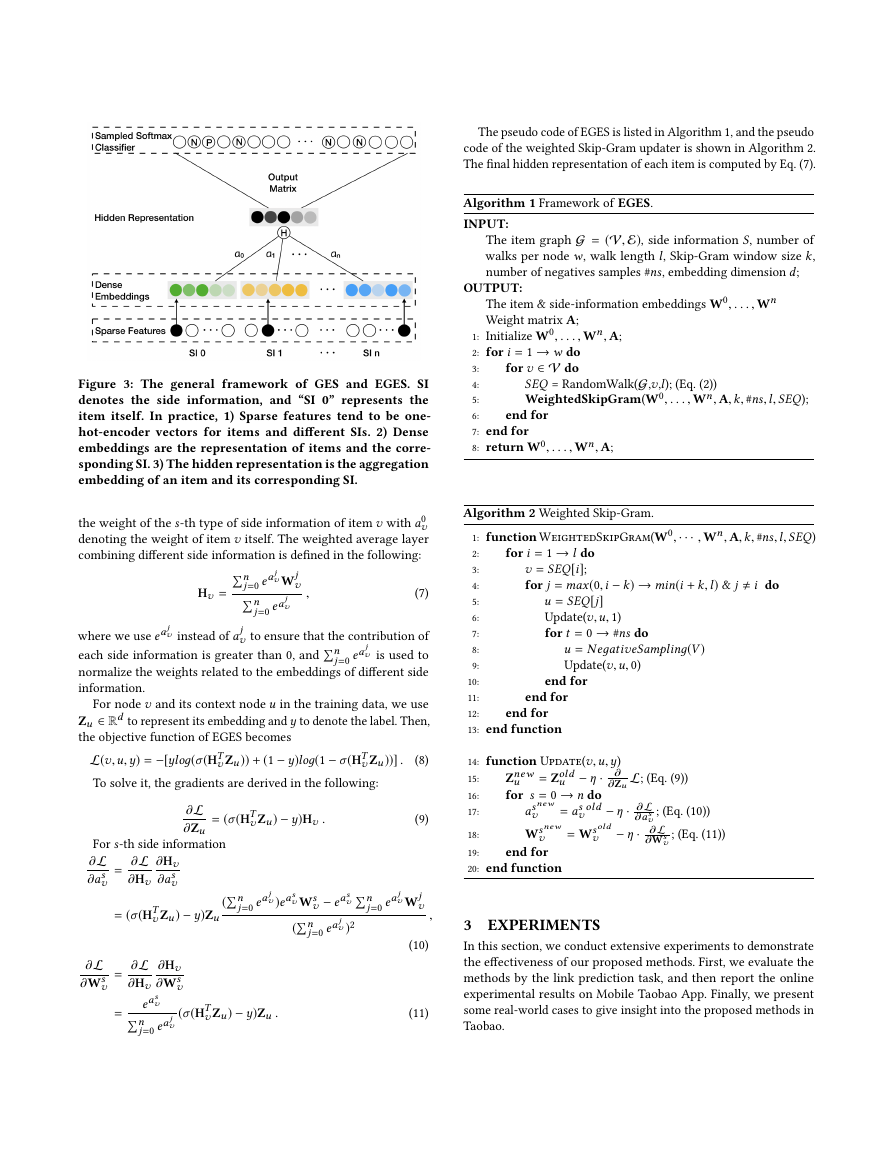
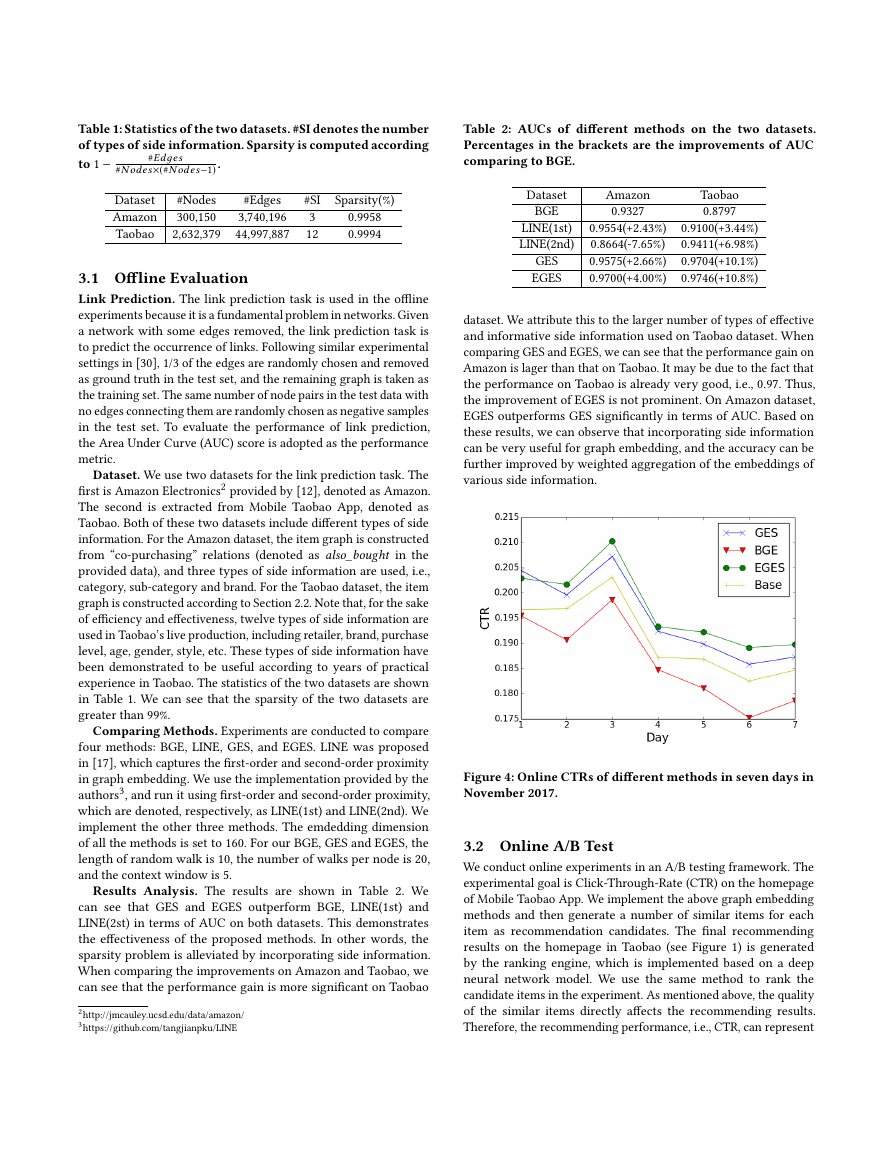
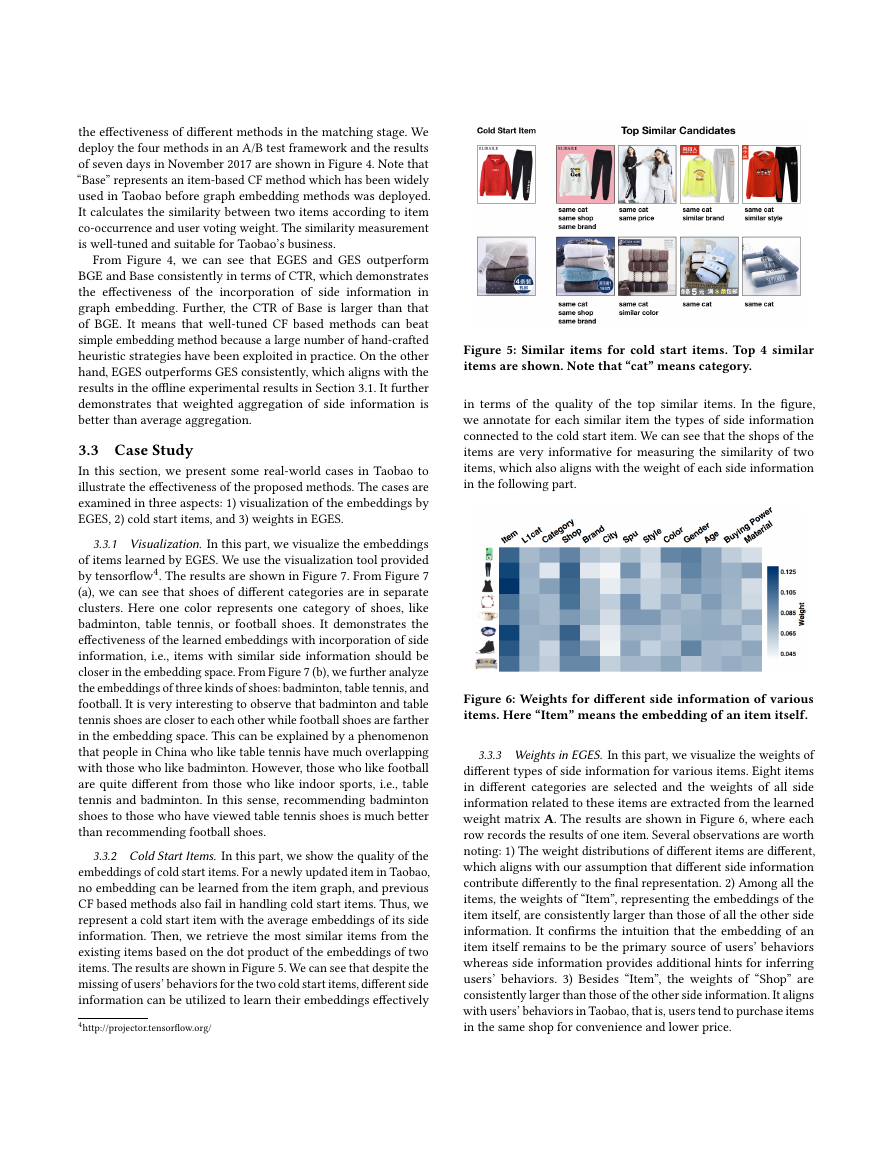
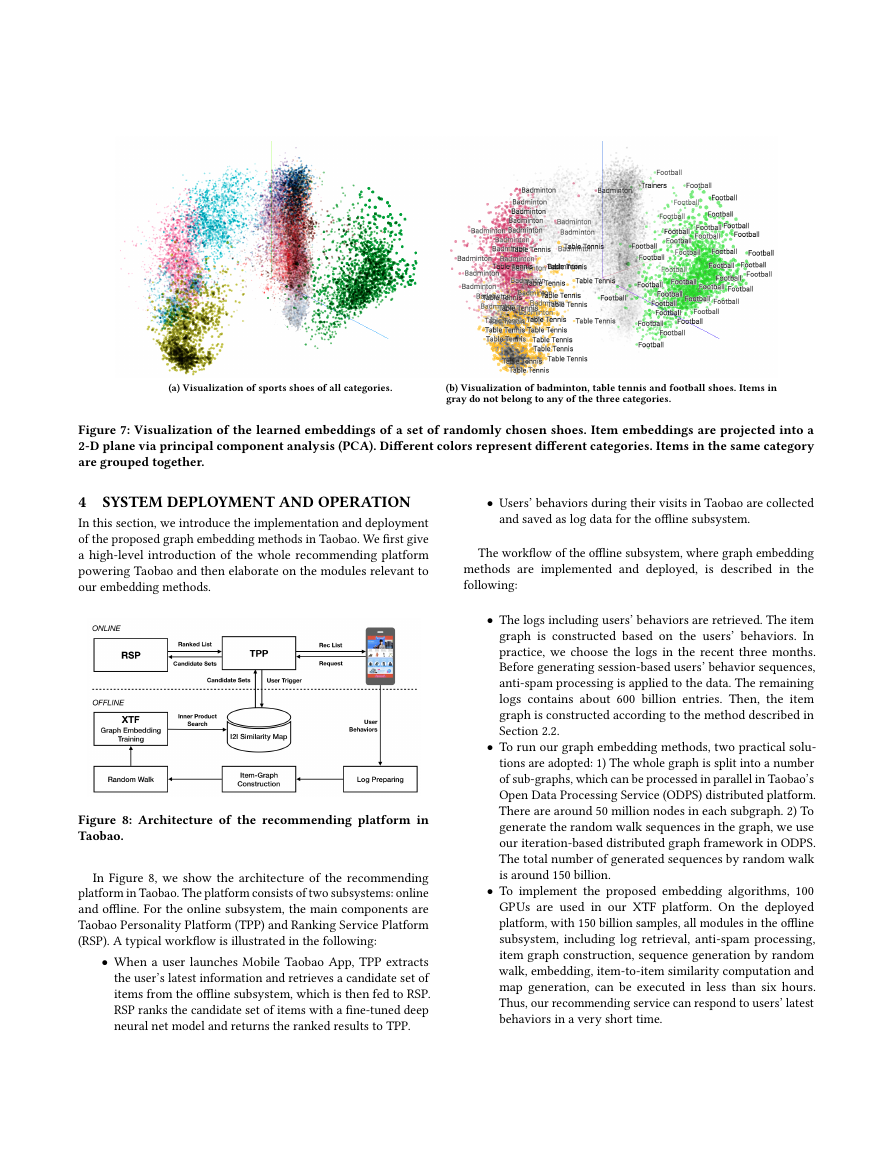








 2023年江西萍乡中考道德与法治真题及答案.doc
2023年江西萍乡中考道德与法治真题及答案.doc 2012年重庆南川中考生物真题及答案.doc
2012年重庆南川中考生物真题及答案.doc 2013年江西师范大学地理学综合及文艺理论基础考研真题.doc
2013年江西师范大学地理学综合及文艺理论基础考研真题.doc 2020年四川甘孜小升初语文真题及答案I卷.doc
2020年四川甘孜小升初语文真题及答案I卷.doc 2020年注册岩土工程师专业基础考试真题及答案.doc
2020年注册岩土工程师专业基础考试真题及答案.doc 2023-2024学年福建省厦门市九年级上学期数学月考试题及答案.doc
2023-2024学年福建省厦门市九年级上学期数学月考试题及答案.doc 2021-2022学年辽宁省沈阳市大东区九年级上学期语文期末试题及答案.doc
2021-2022学年辽宁省沈阳市大东区九年级上学期语文期末试题及答案.doc 2022-2023学年北京东城区初三第一学期物理期末试卷及答案.doc
2022-2023学年北京东城区初三第一学期物理期末试卷及答案.doc 2018上半年江西教师资格初中地理学科知识与教学能力真题及答案.doc
2018上半年江西教师资格初中地理学科知识与教学能力真题及答案.doc 2012年河北国家公务员申论考试真题及答案-省级.doc
2012年河北国家公务员申论考试真题及答案-省级.doc 2020-2021学年江苏省扬州市江都区邵樊片九年级上学期数学第一次质量检测试题及答案.doc
2020-2021学年江苏省扬州市江都区邵樊片九年级上学期数学第一次质量检测试题及答案.doc 2022下半年黑龙江教师资格证中学综合素质真题及答案.doc
2022下半年黑龙江教师资格证中学综合素质真题及答案.doc